
Spring Security提供了我们可以在应用程序中使用的登录和注销功能。创建安全的Spring应用程序很有帮助。
在这里,我们正在使用Spring Security创建一个Spring MVC应用程序,并实现登录和注销功能。
首先,我们创建了一个maven项目,并在pom.xml文件中提供了以下项目依赖项。
项目依赖项
<project xmlns="http://maven.apache.org/POM/4.0.0" xmlns:xsi="http://www.w3.org/2001/XMLSchema-instance" xsi:schemaLocation="http://maven.apache.org/POM/4.0.0 http://maven.apache.org/xsd/maven-4.0.0.xsd"> <modelVersion>4.0.0</modelVersion> <groupId>com.div.cn</groupId> <artifactId>springSecurityLoginOut</artifactId> <version>0.0.1-SNAPSHOT</version> <packaging>war</packaging> <properties> <maven.compiler.target>1.8</maven.compiler.target> <maven.compiler.source>1.8</maven.compiler.source> </properties> <dependencies> <dependency> <groupId>org.springframework</groupId> <artifactId>spring-webmvc</artifactId> <version>5.0.2.RELEASE</version> </dependency> <dependency> <groupId>org.springframework.security</groupId> <artifactId>spring-security-web</artifactId> <version>5.0.0.RELEASE</version> </dependency> <dependency> <groupId>org.springframework.security</groupId> <artifactId>spring-security-core</artifactId> <version>5.0.0.RELEASE</version> </dependency> <dependency> <groupId>org.springframework.security</groupId> <artifactId>spring-security-config</artifactId> <version>5.0.0.RELEASE</version> </dependency> <!-- https://mvnrepository.com/artifact/javax.servlet/javax.servlet-api --> <dependency> <groupId>javax.servlet</groupId> <artifactId>javax.servlet-api</artifactId> <version>3.1.0</version> <scope>provided</scope> </dependency> <dependency> <groupId>javax.servlet</groupId> <artifactId>jstl</artifactId> <version>1.2</version> </dependency> </dependencies> <build> <plugins> <plugin> <groupId>org.apache.maven.plugins</groupId> <artifactId>maven-war-plugin</artifactId> <version>2.6</version> <configuration> <failOnMissingWebXml>false</failOnMissingWebXml> </configuration> </plugin> </plugins> </build> </project>
Spring security配置
此后,我们创建了配置文件以启用登录功能并仅允许授权用户访问。
该项目包含以下四个Java文件。
AppConfig.java
package com.div.cn;
import org.springframework.context.annotation.Bean;
import org.springframework.context.annotation.ComponentScan;
import org.springframework.context.annotation.Configuration;
import org.springframework.web.servlet.config.annotation.EnableWebMvc;
import org.springframework.web.servlet.view.InternalResourceViewResolver;
import org.springframework.web.servlet.view.JstlView;
@EnableWebMvc
@Configuration
@ComponentScan({ "com.div.cn.controller.*" })
public class AppConfig {
@Bean
public InternalResourceViewResolver viewResolver() {
InternalResourceViewResolver viewResolver
= new InternalResourceViewResolver();
viewResolver.setViewClass(JstlView.class);
viewResolver.setPrefix("/WEB-INF/views/");
viewResolver.setSuffix(".jsp");
return viewResolver;
}
}MvcWebApplicationInitializer.java
package com.div.cn;
import org.springframework.web.servlet.support.AbstractAnnotationConfigDispatcherServletInitializer;
public class MvcWebApplicationInitializer extends
AbstractAnnotationConfigDispatcherServletInitializer {
@Override
protected Class<?>[] getRootConfigClasses() {
return new Class[] { WebSecurityConfig.class };
}
@Override
protected Class<?>[] getServletConfigClasses() {
// TOdo Auto-generated method stub
return null;
}
@Override
protected String[] getServletMappings() {
return new String[] { "/" };
}
}SecurityWebApplicationInitializer.java
package com.div.cn;
import org.springframework.security.web.context.*;
public class SecurityWebApplicationInitializer
extends AbstractSecurityWebApplicationInitializer {
}WebSecurityConfig.java
package com.div.cn;
import org.springframework.context.annotation.*;
//import org.springframework.security.config.annotation.authentication.builders.*;
import org.springframework.security.config.annotation.web.builders.HttpSecurity;
import org.springframework.security.config.annotation.web.configuration.*;
import org.springframework.security.core.userdetails.User;
import org.springframework.security.core.userdetails.UserDetailsService;
import org.springframework.security.provisioning.InMemoryUserDetailsManager;
import org.springframework.web.servlet.config.annotation.WebMvcConfigurer;
@EnableWebSecurity
@ComponentScan("com.div.cn")
public class WebSecurityConfig extends WebSecurityConfigurerAdapter {
@Bean
public UserDetailsService userDetailsService() {
InMemoryUserDetailsManager manager = new InMemoryUserDetailsManager();
manager.createUser(User.withDefaultPasswordEncoder()
.username("irfan").password("khan").roles("ADMIN").build());
return manager;
}
@Override
protected void configure(HttpSecurity http) throws Exception {
http
.authorizeRequests()
.anyRequest().hasRole("ADMIN")
.and().formLogin().and()
.httpBasic()
.and()
.logout()
.logoutUrl("/j_spring_security_logout")
.logoutSuccessUrl("/")
;
}
}控制器
HomeController: 处理用户请求的控制器。
package com.div.cn.controller;
import javax.servlet.http.HttpServletRequest;
import javax.servlet.http.HttpServletResponse;
import org.springframework.security.core.Authentication;
import org.springframework.security.core.context.SecurityContextHolder;
import org.springframework.security.web.authentication.logout.SecurityContextLogoutHandler;
import org.springframework.stereotype.Controller;
import org.springframework.web.bind.annotation.RequestMapping;
import org.springframework.web.bind.annotation.RequestMethod;
@Controller
public class HomeController {
@RequestMapping(value = "/", method = RequestMethod.GET)
public String index() {
return "index";
}
@RequestMapping(value="/logout", method=RequestMethod.GET)
public String logoutPage(HttpServletRequest request, HttpServletResponse response) {
Authentication auth = SecurityContextHolder.getContext().getAuthentication();
if (auth != null){
new SecurityContextLogoutHandler().logout(request, response, auth);
}
return "redirect:/";
}
}视图
我们有一个JSP文件 index.jsp ,其中包含以下代码。
<%@ page language="java" contentType="text/html; charset=UTF-8"pageEncoding="UTF-8"%>
<%@ taglib prefix="c" uri="http://java.sun.com/jsp/jstl/core"%>
<!DOCTYPE html public "-//W3C//DTD HTML 4.01 Transitional//EN"
"http://www.w3.org/TR/html4/loose.dtd">
<html>
<head>
<meta http-equiv="Content-Type" content="text/html; charset=UTF-8">
<title>Home</title>
</head>
<body>
<h3> Hello ${pageContext.request.userPrincipal.name}, </h3>
<h4>Welcome to Nhooo! </h4>
<a href="/spring/<c:url value='/logout' />">Click here to logout</a>
</body>
</html>项目结构
创建上述文件后,我们的项目结构如下所示:
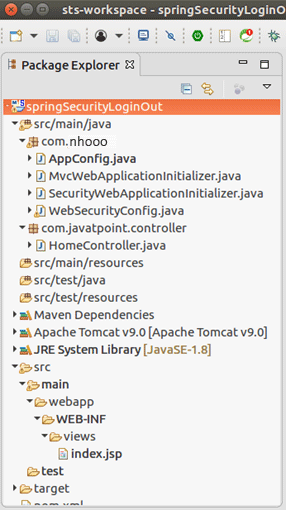
输出
使用apache tomcat运行时,它将向浏览器生成以下输出。
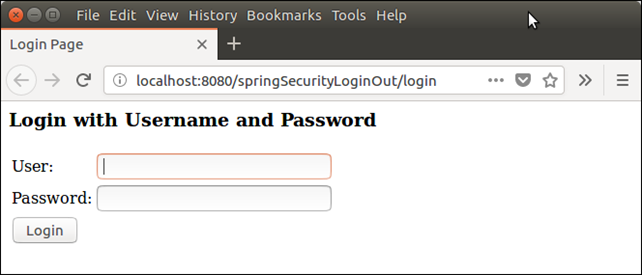
现在,提供要登录的用户凭据。
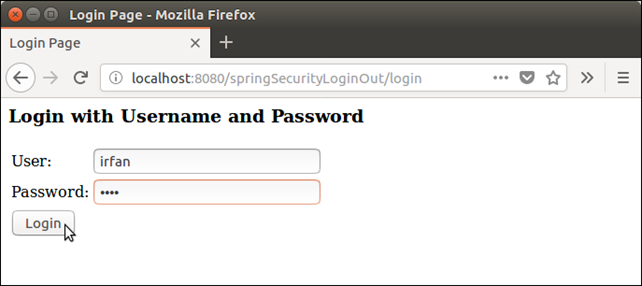
成功登录后显示首页,请参见下文。
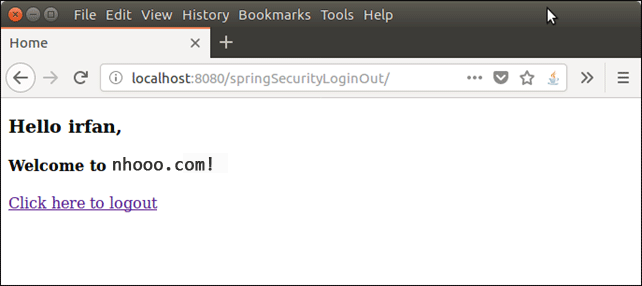
在这里,我们创建了一个注销链接,可用于注销。让我们检查一下并从应用程序中注销。
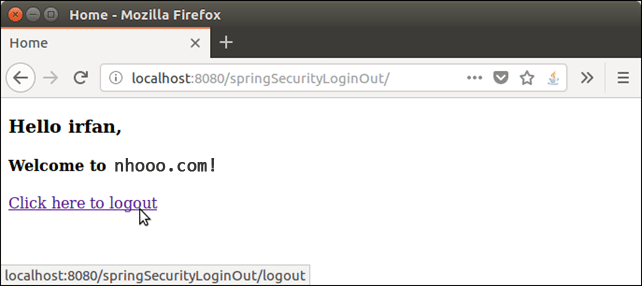
它重定向回到登录页面。
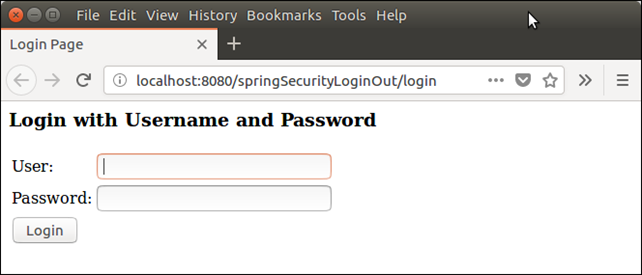
我们已经成功创建了一个Spring MVC应用程序使用Spring Security实现登录和注销功能。
